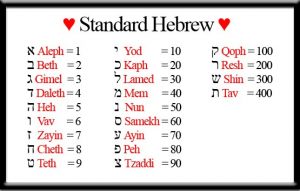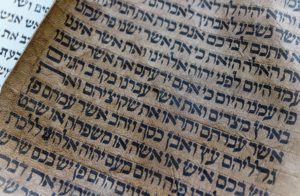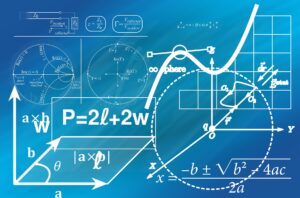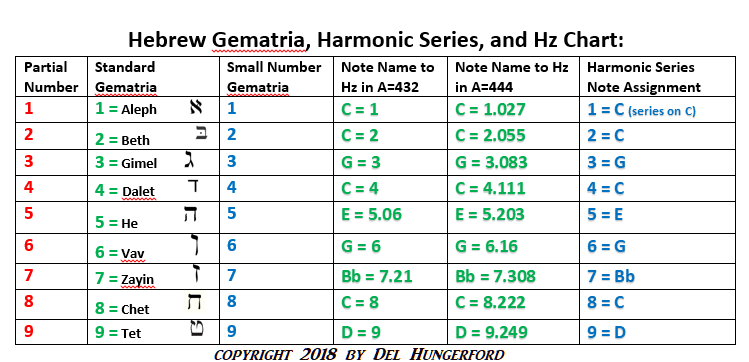During my quest in search of possible musical frequencies in the Hebrew letters, I found many others blazed a similar trail. People looked at the cantillation marks, standard gematria as the actual pitch, or a combination of other ways to determine how to play and sing Hebrew sentences, words, and letters. Many require a variety of pre-steps to make the system/method functional. Ancients created music that fit within the law of harmonics. It was simple and only required a good listening ear (for tuning). Archeaomusicology shows this is the case. It wasn’t until the time of Pythagoras (500 BCE) that we had an explanation of musical harmonics and how it worked. But, that doesn’t mean people didn’t use it.
 In this article, I explain Hebrew gematria. For more information on how musical harmonics plays into this scenario, CLICK HERE to read that article. Tuning is another piece that must be considered. Healing Frequencies Music is a website where we explore anything to do with musical frequencies. It’s only natural that I’d explore reports that the Hebrew letters have a musical frequency assigned to them. My problem? No one seemed to know and those who thought they knew, had differing opinions. Some of those opinions came from people who don’t understand the inner workings of music. On the other hand, I’m not a Jewish scholar so I had to speak with people in the Jewish community and do a ton of homework on the Hebrew culture. Maybe that’s one reason it took me a long time to complete this project.
In this article, I explain Hebrew gematria. For more information on how musical harmonics plays into this scenario, CLICK HERE to read that article. Tuning is another piece that must be considered. Healing Frequencies Music is a website where we explore anything to do with musical frequencies. It’s only natural that I’d explore reports that the Hebrew letters have a musical frequency assigned to them. My problem? No one seemed to know and those who thought they knew, had differing opinions. Some of those opinions came from people who don’t understand the inner workings of music. On the other hand, I’m not a Jewish scholar so I had to speak with people in the Jewish community and do a ton of homework on the Hebrew culture. Maybe that’s one reason it took me a long time to complete this project.
I was enthralled by the idea that a number assigned to a letter could also represent a musical frequency. It helped that some friends and customers lit a fire under me to do it. So, what is gematria and how does it correlate to musical frequencies (pitches)? Here’s an example of how numbers connect in mysterious ways… When I discovered that by taking shapes, adding up the inside angles (180, 360, 720, etc.), and putting those numbers to musical frequencies, those frequencies create an F# Major triad. If you want more information, CLICK HERE to read that article. This told me there are numerical connections in other places. Does one of those connections have anything to do with the Hebrew alphabet and musical pitches? It was time to find out.
What is Gematria?
Gematria is assigning numbers to each letter of an alphabet. It’s most commonly associated with the Hebrew language. For more specifics, check out the site, My Jewish Learning. Their definition says that “gematria is a numerological system by which Hebrew letters correspond to numbers. This system, developed by practitioners of Kabbalah (Jewish mysticism), derived from Greek influence and became a tool for interpreting biblical texts.”
For those who would like more information on how gematria came about and what it’s used for, the article on My Jewish Learning is a great starting point. In another article that I found, the writer discusses evidence of gematria as far back as 1700 BCE. CLICK HERE to read that article by John Opsopaus. The historical time-line for gematria in the Ospopaus article looks like this:
- 1700 BCE: proto-Canaanite
- 1100 BCE: archaic Greek derived from proto-Canaanite
- 1050 BCE: proto-Canaanite to Phoenician
- 800 BCE: Early Hebrew – derived from Phoenician
- 700 BCE: Aramaic derived from Phoenician
- 650 BCE: Latin derived from Greek
- 200 BCE: Square Hebrew derived from Aramaic (adding the 5 letters with final forms)
 We know the Hebrew Torah in its current form is at least 2,000 years old. CLICK HERE for an article about a discovery of a scroll in a destroyed synagogue when it was excavated in 1970. There were several scrolls found inside the destroyed temple’s ark. The charred remains were taken in for a “virtual unwrapping.” Imaging provides a 3D digital analysis of an X-ray scan. With this technology, they were able to read one scroll. That scroll lined up perfectly with more current versions of the Torah text. In other words, very little changed over time in the Torah. I believe this includes the way the Hebrew culture used gematria.
We know the Hebrew Torah in its current form is at least 2,000 years old. CLICK HERE for an article about a discovery of a scroll in a destroyed synagogue when it was excavated in 1970. There were several scrolls found inside the destroyed temple’s ark. The charred remains were taken in for a “virtual unwrapping.” Imaging provides a 3D digital analysis of an X-ray scan. With this technology, they were able to read one scroll. That scroll lined up perfectly with more current versions of the Torah text. In other words, very little changed over time in the Torah. I believe this includes the way the Hebrew culture used gematria.
Keep in mind that the Israelites lived in the land of Canaan between 1250 -1050 BCE. According to the above timeline, there’s evidence of gematria used by the Canaanites as early as 1700 BCE. Before this time, there’s record of the Israelites living in Egypt, where those from other lands (including the Canaanites) visited on a regular basis. These cultures intertwined with one another, much like cultures intertwine today. It only makes sense that the Israelites knew about and used gematria long before it’s actually recorded (that we know about).
In Jewish mysticism, they believe that each Hebrew letter carries energy. Gematria actually comes from a Greek version relating to the word “geometry.” When assigning a number to a letter, in a sense, that adds to the energy of that letter. When the two combine to make full words, that brings a new energy into the mix. As proposed throughout this website, energy = frequency.
I find it interesting that the Jews began assigning numbers to letters a very long time ago. What inspired them to do this? What was the purpose for doing so? There are many scholars who try to answer these questions but I’m not sure it’s totally possible. What I do know is that we have a community of people who somehow figured out that assigning numbers to an alphabet was important. Jewish mystics tell of that importance as they discuss the Hebrew aleph-bet as “living letters.” If they are living, there’s a frequency associated with them. Energy = frequency. When a belief is held and practiced consistently over thousands of years, there must be something to it. In comparing this to modern practices and belief systems, we’re lucky if we can keep a strong conviction for 10 years or more let alone over 3,000 years! Not much has changed in the way the Hebrew culture views the use of gematria. We only have evidence of HOW it was used from 200 BCE forward.
An Objective Look
Part of my decision to tackle this monumental task involved what I share above. I used the long-held belief that the Hebrew aleph-bet is also represented by musical frequencies. Each letter tells a story, which then becomes a part of the interpretation of each word. Each letter carries a frequency which in turn adds to the character of each word. You might be thinking, “But, the musical scale only has 12 notes and the Hebrew alphabet has 22 (or 27) letters.” Several of the letters are made up of other letters. There are also several letters that have the same fundamental frequency, as I discovered. However, this falls in line with what I stated above; some letters have parts of other letters combined to make a new letter. When looking at this musically, there’s the same type of relational overlap. What changes is the context in how those musical frequencies are treated within the full word.

Image by Pixabay
For some, this may fit in the land of “woo woo” where it’s too far out to believe. Gematria is a form of numerology. There are many who “poo poo” it saying that it means nothing. I’ll venture to guess those who say that haven’t looked into it enough and then take what others say as truth. When numbers start connecting in several places (nature, math, geometry, etc.), there has to be something to it. I don’t think those occurrences are by accident. To me, it’s an invitation to look for the truth IN something. Not everything extracted is truth because mankind does tend to force things into pre-formed structures. Good research requires an objective look where all expectations are thrown out the window. Look for the connecting bits in what falls together naturally without forcing them to fit. That’s the approach I took with this project. I didn’t want to force anything. I followed the numbers where they took me.
Proposal
I propose that the Israelites understood gematria and its purpose earlier than currently understood. It’s probable there’s a musical representation of a letter/word/phrase. Look throughout the Hebrew Bible and it doesn’t take much to realize the importance of numbers. It’s not a stretch of the imagination to also consider that each letter not only has a gematria number assigned to it but also a musical frequency. There are many layers that combine to make a whole.
It’s possible there are single frequencies as well as full melodies (using gematria of sentences) within the Hebrew letters. As more excavations of ancient civilizations take place, more evidence may show up. Because the ancients didn’t have technology as we know it today, they relied on what they witnessed in nature or received by divine inspiration. Take the pyramids for example. Scholars can’t seem to agree on how such large stones were moved. What is it the ancients knew that we are at a loss for today? I believe they understood energy and how to use it in ways we’ve never thought of because we’re too stuck on modern technology. We can’t get out of that box enough to see that there are other ways of getting things done.
This next image shows the first 9 letters of the Hebrew alphabet with frequencies, partial numbers (of the harmonic series), two forms of gematria, and a comparison of the A=432 and A=444 concert pitches. Look at the similarities as you make your own conclusions. If you want the rest of the chart, it’s available for purchase by CLICKING HERE.

I can’t ignore the obvious in my research – that gematria in the Hebrew alphabet lines up with specific musical frequencies in the A=432 concert pitch and the musical harmonic series. As you can see from the above chart, the A=444 concert pitch is too far off. I don’t believe any of this is a freak of nature. Somehow, I think this all fits within the whole of something and it’s a matter of time before we’ll understand how all these puzzle pieces fit so nicely together.
I’ll leave you with that for further pondering…
Del
© 2018 by Del Hungerford
[mailerlite_form form_id=2]


[…] Standard Hebrew Gematria יוסף סמית Joseph (Yod = 10, Vav = 6, Samekh = 60, Peh = 80) Smith (Samekh = 60, Mem = 40, Yod = 10, Tav = 400) = 666 […]
[…] ₃ https://www.healingfrequenciesmusic.com/musical-frequencies-of-hebrew-letters-gematria-explained/ […]